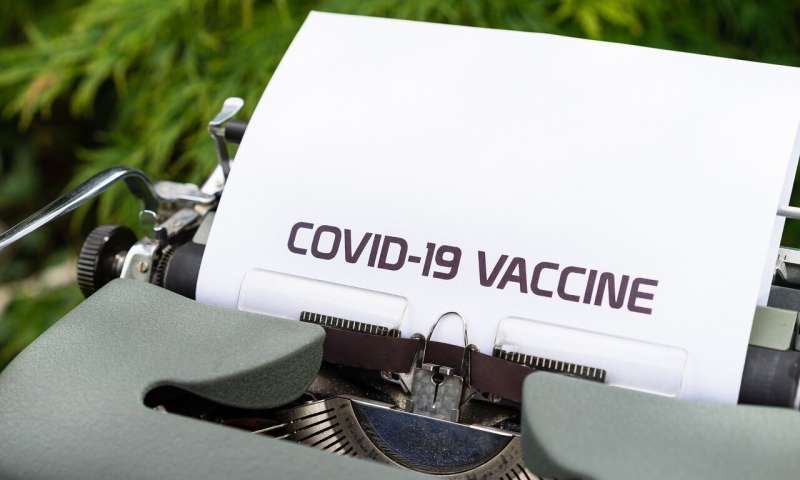
Vivid photos of the red “COVID arm” rash and reports of facial swelling in patients who have received dermatological fillers after Pfizer-BioNTech or Moderna vaccination for COVID-19 may increase patients’ concerns about mRNA vaccine side effects and contribute to vaccine hesitancy. A comprehensive review in Clinics in Dermatology, conducted by University of Connecticut School of Medicine researchers and published by Elsevier, confirms that almost all cutaneous reactions are largely self-limited and should not discourage getting the vaccine.
The authors reviewed literature published as of May 2021 describing cutaneous side effects from the currently authorized m-RNA vaccines and supplemented their analysis with data from the Centers for Disease Control and Prevention’s Vaccine Adverse Event Reporting System (CDC-VAERS).
“Usually, the cutaneous reactions described are not a cause for concern,” explained co-author Christian Gronbeck, MD, UConn School of Medicine, Farmington, CT, USA. “Existing reports should reassure patients of the overall compelling safety profiles and benignity of skin reactions following mRNA COVID-19 vaccination.”
Local injection site reactions may occur shortly after vaccine administration and may take the form of swelling, redness/erythema, and/or pain. The incidence rate reported in studies reviewed by Dr. Gronbeck and his coauthor Jane M. Grant-Kels, MD, UConn School of Medicine Department of Dermatology, Farmington, CT, USA, range from 5.5 percent to 23.7 percent. The published reports agree that these reactions are harmless, transient, and largely resolve within two to five days. It is important to distinguish these reactions from immediate allergic-type hypersensitivity reactions, such as angioedema, respiratory distress, or anaphylaxis that occur within four hours of vaccination. However, existing studies provide reassurance to patients and providers because dermatological symptoms are transient and rarely associated with anaphylaxis.
Delayed local reactions, typically erythema with mild hardening of the tissue at the injection site, occur days rather than hours, after injection with the Moderna vaccine. They are temporary and may be less frequent after the second dose. They likely represent T-cell-mediated hypersensitivity, and the authors agree that they likely do not lessen vaccine safety. “Recognition of delayed reactions is nonetheless important,” Dr. Gronbeck and Dr. Grant-Kels said, “to both guide patient expectations and avoid unnecessary medical treatment.”
Rarely reported and more unusual cutaneous reactions to the mRNA COVID-19 vaccines have occurred, although reports are very limited and it is difficult to identify overall incidence rates. Crusted, vesicular, painful skin lesions, consistent with herpes zoster reactivation, have been reported following both the Pfizer and Moderna vaccines. It has been postulated that immunomodulary effects of the COVID-19 vaccines may have promoted zoster reactivation and further studies are needed. In the meantime, the authors suggest heightened monitoring for patients with risk factors.
Several cases of facial swelling in patients with a history of dermatological fillers have been reported after COVID-19 vaccination. Although rare, these events are important to recognize amidst the expansion of vaccines to the general population and the growing popularity of dermal fillers.
The CDC-VAERS currently lists 260 reports of immune thrombocytopenia (ITP), a disorder characterized by excessive bruising and bleeding caused by lowered platelet levels. Case reports suggest that it may present differently and occur in varying patient populations. Some studies hypothesize that the cause may be immune-mediated platelet destruction following the COVID vaccine. However, given the overall rarity, researchers have also considered that underlying autoimmune or another disease may play a role. Optimal treatment must be further studied, given that aggressive immunosuppression may dampen the desired immune response from the vaccines.
The authors observed that most studies and the VAERS data do not include incidence rates among all vaccinated individuals, making it difficult to estimate the specific frequency of each reaction. Also, many studies reported reactions in healthcare workers, which may not reflect the broader population. Despite these shortcomings, Dr. Grant-Kels said, “We propose several reassuring clinical considerations for those who are hesitant to be vaccinated. First, the reported reactions are largely self-limited, and the most frequent reactions were also found in the clinical trials of the drugs, which have been authorized for use in the general population. Allergic-type symptoms are transient and rarely associated with anaphylaxis. The development of uncommon reactions such as herpes zoster, dermal filler reactions, and ITP were seldom serious in nature but justify clinical monitoring.”
Source: Read Full Article
